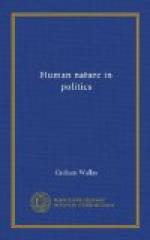In all this again the same rule holds as in the production of impulse. Things that are nearer sense, nearer to our more ancient evolutionary past, produce a readier inference as well as a more compelling impulse. When a new candidate on his first appearance smiles at his constituents exactly as if he were an old friend, not only does he appeal, as I said in an earlier chapter, to an ancient and immediate instinct of human affection, but he produces at the same time a shadowy belief that he is an old friend; and his agent may even imply this, provided that he says nothing definite enough to arouse critical and rational attention. By the end of the meeting one can safely go as far as to call for three cheers for ’good old Jones.’[21]
[21] Three-quarters of the art of the trained salesman depends upon his empirical knowledge of this group of psychological facts. A small girl of my acquaintance, explaining why she had brought back from her first independent shopping expedition a photograph frame which she herself found to be distressing, said: ’The shopman seemed to suppose I had chosen it, and so I paid for it and came away.’ But her explanation was the result of memory and reflection. At the moment, in a shadowy way which was sufficient for the shopman, she supposed that she had chosen it.
Mr. G.K. Chesterton some years ago quoted from a magazine article on American elections a sentence which said: ’A little sound common-sense often goes further with an audience of American working men than much high-flown argument. A speaker who, as he brought forward his points, hammered nails into a board, won hundreds of votes for his side at the last Presidential election.’[22] The ‘sound common-sense’ consisted, not, as Mr. Chesterton pretended to believe, in the presentation of the hammering as a logical argument, but in the orator’s knowledge of the way in which force is given to non-logical inference and his willingness to use that knowledge.




